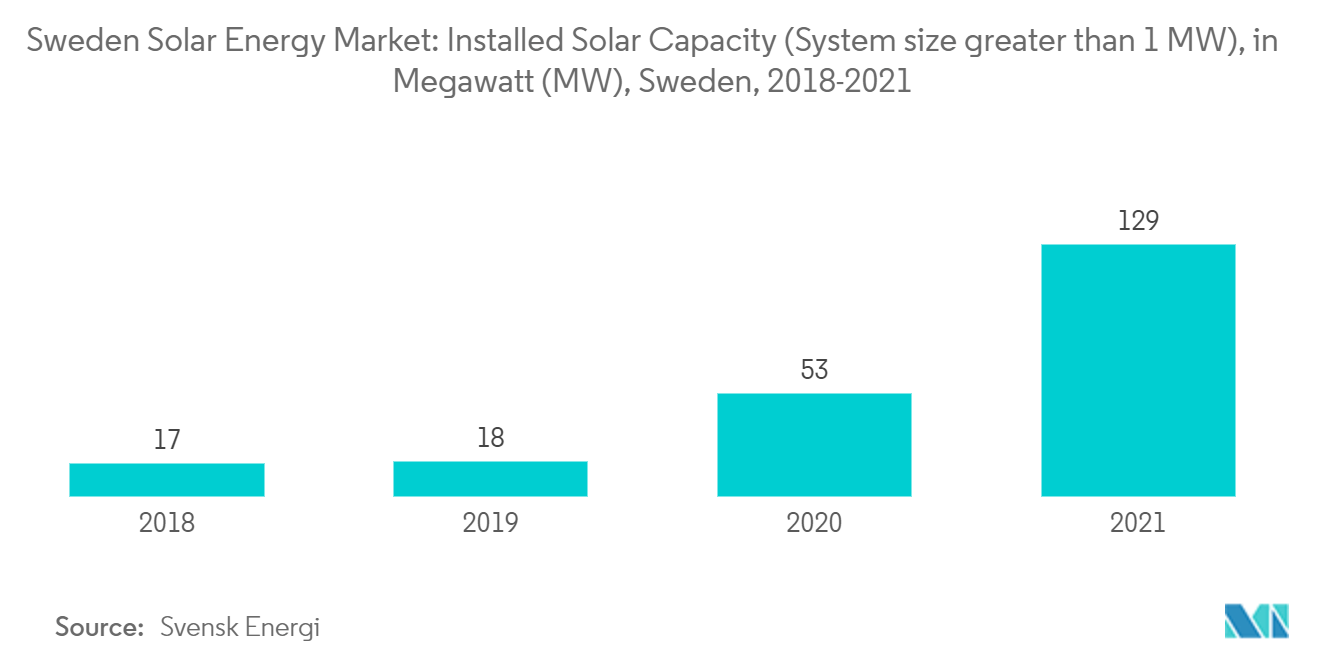Market Trends of Sweden Solar Energy Industry
This section covers the major market trends shaping the Sweden Solar Energy Market according to our research experts:
The Ground-mounted Segment is Expected to Grow Significantly During the Forecast Period
- Swedish solar energy is dominated by the rooftop segment, with the ground-mounted segment accounting for a minor share of the market.
- However, the interest and activity in this market segment have increased significantly since 2020. The number and sizes of ground-mounted solar PV parks are expected to increase during the forecast period.
- In 2021, Sweden's total installed capacity of solar PV systems with sizes greater than 1 MW was 129 MW, greater than twice the installed capacity in 2020 (53 MW). However, growing private investments and declining costs of PV systems are expected to drive the market during the forecast period.
- Ground-mounted installations ranging from 800 kW to 7 MW are being developed by local municipality-owned utilities, including Kalmar, Luleå, Falu, Trollhättan, and Lidkoping.
- Several large utility-scale projects are also being developed by private players. For instance, in March 2022, the Swedish renewable developer Recap Energy and Finnish investment company Korkia signed a joint venture (JV) to develop more than 200MWp of ground-mounted solar PV projects in Sweden over the next four years. The newly formed JV will aim to sell shovel-ready projects that are backed either by signing corporate power purchase agreements (PPAs) or merchant-based revenue schemes.
- Moreover, in 2022, Helios Nordic Energy AB entered into an agreement with Nordic Solar to acquire four ground mounted projects in Helios project pipeline in the south of Sweden, of which three are in SE3 and one in SE4. They have a total combined capacity of approximately 220 MWp.
- Therefore, with decreasing costs and increasing investments by municipalities and private players, the growth of the ground-mounted segment is expected to be the fastest-growing segment during the forecast period.

Soaring Electricity Prices to Incentivize the Installation of Solar PV Systems for Self-consumption
- In the past couple of years, there has been a significant rise in the demand for electricity from the residential and industrial sectors. According to the Swedish Energy Agency, the total energy consumption in Sweden is expected to increase by 5% to 523 TWh between 2020 and 2024. Further, the industrial sector is expected to witness a surge in demand for electricity; energy use will increase by 5.1% to 143 TWh in 2024. Energy demand in the residential sector is anticipated to rise by 3.6% to 145 TWh during 2020-2024.
- Additionally, since the start of the Russia-Ukraine conflict, energy prices in Europe have skyrocketed. Sweden already has one of the highest electricity prices in Europe. As of August 2022, the average monthly electricity wholesale price was EUR 190.12/MWh, up by nearly 350% from EUR 54.34/MWh in January 2019.
- The country largely depends on hydropower and nuclear power for its electricity generation. According to the Swedish government, as of August 2022, in the total energy generation mix, hydropower contributes more than 38%, and nuclear power provides more than 29%.
- Since 2012, there have been more than 17% decline in the electricity generated from nuclear power as the country started phasing out nuclear power. In 2020, the Swedish government shut down two nuclear power reactors, Barsebäck 1 and 2. Furthermore, Ringhals 2 and Ringhals 1 nuclear power plants were permanently shut down after 44 years of operation in 2020 and 2021, respectively.
- Moreover, Vattenfall AB, a leading nuclear power company, has five operational nuclear power plants in the country. However, due to a lack of government policies for storing nuclear waste, the company would have to halt the operations in four nuclear power plants in the country till 2025, which is likely to result in significantly higher electricity prices during the forecast period.
- Hence, due to falling nuclear generation and rising gas prices across the continent caused by the geopolitical effects of the Russia-Ukraine conflict, the price of electricity in Sweden is expected to increase significantly, incentivizing the installation of solar panels for self-consumption, driving the demand for solar energy during the forecast period.


